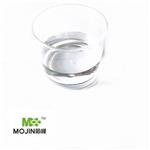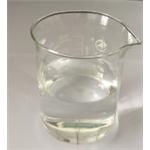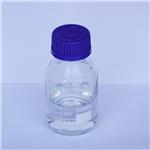- Methyltrichlorosilane
-

- $0.00 / 25KG
-
2023-09-27
- CAS:75-79-6
- Min. Order: 1KG
- Purity: 99%
- Supply Ability: 50000KG/month
- Methyltrichlorosilane
-

- $50.00 / 1kg
-
2023-09-23
- CAS:75-79-6
- Min. Order: 1kg
- Purity: 99%
- Supply Ability: 20 tons
- Methyltrichlorosilane
-

- $30.00 / 1KG
-
2023-09-06
- CAS:75-79-6
- Min. Order: 50KG
- Purity: 99%
- Supply Ability: 500000kg
|
| | Methyltrichlorosilane Basic information |
| | Methyltrichlorosilane Chemical Properties |
| Melting point | -77 °C | | Boiling point | 66 °C (lit.) | | density | 1.273 g/mL at 25 °C (lit.) | | vapor density | 5.2 (vs air) | | vapor pressure | 150 mm Hg ( 25 °C) | | refractive index | n20/D 1.411 | | Fp | 5 °F | | storage temp. | Flammables area | | solubility | sol methylene chloride. | | form | liquid | | Specific Gravity | 1.275 | | color | colorless | | explosive limit | 5.5-10.4%(V) | | Water Solubility | REACTS | | FreezingPoint | -77.8℃ | | Sensitive | Moisture Sensitive | | Hydrolytic Sensitivity | 8: reacts rapidly with moisture, water, protic solvents | | BRN | 1361381 | | Stability: | Stable, but reacts violently with water. Highly flammable. Incompatible with moisture, water, strong bases, strong acids, strong oxidizing agents. | | InChIKey | JLUFWMXJHAVVNN-UHFFFAOYSA-N | | CAS DataBase Reference | 75-79-6(CAS DataBase Reference) | | NIST Chemistry Reference | Silane, trichloromethyl-(75-79-6) | | EPA Substance Registry System | Methyltrichlorosilane (75-79-6) |
| | Methyltrichlorosilane Usage And Synthesis |
| Description | Methyltrichlorosilane is a colorless liquid witha sharp hydrochloric acid-like odor. Molecularweight 5 149.48; Boiling point = 66℃; Freezing/Meltingpoint 5290℃; Vapor pressure 5 146.7 mmHg at 18℃;Flash point = 2 6.2℃; 2 8℃ (cc); Autoignition temperature $404℃. Explosive limits: LEL 5 7.6%; UEL $20%.Hazard Identification (based on NFPA-704 M RatingSystem): Health 3, Flammability 3, Reactivity 2 . Reactswith water. | | Chemical Properties | Colorless clear liquid | | Physical properties | bp 66 °C; d 1.273 g cm?3. | | Uses | Methyltrichlorosilane is widely used as precursor to organosilicon compounds; silylating agent and
Lewis acid. MeSiCl3 is an effective Lewis
acid in the condensation of carboxylic acids with alcohols and
amines. | | Uses | Intermediate for silicones. | | Uses | Methyltrichlorosilane is used in production of methyl silicone resins, its vapor reacts with water on surfaces to give a thin layer of methylpolysiloxane which make it a water-repellent film. A combination of methyltrichlorosilane and sodium iodide can be used to cleave carbon-oxygen bonds such as methyl ethers. It is used as a precursor for forming various cross-linked siloxane polymers. Trichloromethylsilane is the starting material for the production of pure silicon for manufacture of semiconductors and optical fibers. | | Production Methods | Produced by Grignard reaction of silicon tetrachloride and
methylmagnesium chloride. | | General Description | A colorless fuming liquid with a pungent odor. Flash point 8°F. Vapor and liquid may cause burns. Denser than water. Vapors are heavier than air. | | Reactivity Profile | Chlorosilanes, such as Methyltrichlorosilane, are compounds in which silicon is bonded to from one to four chlorine atoms with other bonds to hydrogen and/or alkyl groups. Chlorosilanes react with water, moist air, or steam to produce heat and toxic, corrosive fumes of hydrogen chloride. They may also produce flammable gaseous H2. They can serve as chlorination agents. Chlorosilanes react vigorously with both organic and inorganic acids and with bases to generate toxic or flammable gases. | | Hazard | Flammable, dangerous fire risk, may formexplosive mixture with air. Strong irritant. | | Health Hazard | As with other chlorosilanes, acute exposures may be highly toxic and may cause death or permanent injury after very short exposures to small quantitites. Chronic exposures may be moderately toxic and involve irreversible and reversible changes. Skin contact may produce severe burns with pain and risk of secondary infections. Ingestion may produce oral, esophageal, and stomach burns, intensity will vary from mild to very severe, gastrointestinal damage is rare but may occur. | | Fire Hazard | Toxic hydrogen chloride and phosgene gases may form in fires. Reacts with water or steam to form hydrochloric acid. Vapor forms flammable mixture with air. May form explosive mixture in air. Avoid contact with water or moist air. | | Safety Profile | Poison by inhalation
and intraperitoneal routes. Moderately toxic
by ingestion. A severe irritant to skin, eyes,
and mucous membranes. Flammable when
exposed to heat or flame; can react
vigorously with oxidizing materials. When
heated to decomposition it emits toxic
fumes of Cl-. | | Potential Exposure | PrimaryIrritant. Methyltrichlorosilane is used as an intermediate tomake silicones; for making water repellants, electrical insulation, heat-resistant paints, and other products. | | First aid | If this chemical gets into the eyes, remove anyContact lenses at once and irrigate immediately for at least[5 min, occasionally Iifting upper and lower lids. Seek med-ical attention immediately. If this chemical contacts theskin, remove contaminated clothing and wash immediatelywith soap and water. Seek medical attention immediately. Ifthis chemical has been inhaled, remove from exposure.begin rescue breathing (using universal precautions, includ-ing resuscitation mask) if breathing has stopped and CPR iheart action has stopped. Transfer promptlyto a medicalfacility. When this chemical has been swallowed, get medi-attention. If victim is conscious, administer water ormilk. Do not induce vomiting. Medical observation isrecommended for 24- 48h after breathing overexposure, aspulmonary edema may be delayed. As first aid for pulmo-nary edema, a doctor or authorized paramedic may consideradministering a corticosteroid spray. | | storage | Color Code—Red: Flammability Hazard: Store ina flammable liquid storage area or approved cabinet awayfrom ignition sources and corrosive and reactive materials.Prior to working with this chemical you should be trainedon its proper handling and storage. Before entering confinedspace where this chemical may be present, check to makesure that an explosive concentration does not exist.Methyltrichlorosilane must be stored to avoid contact withwater, acids, chemically active metals (such as potassium,sodium, magnesium, and zinc), and alkalis since violentreactions occur and hydrogen chloride is produced. Store intightly closed containers in a cool, well-ventilated areaaway from heat. Sources of ignition, such as smoking andopen flames, are prohibited where methyltrichlorosilane ishandled, used, or stored. Metal containers involving thetransfer of 5 gallons or more of methyltrichlorosilaneshould be grounded and bonded. Drums must be equippedwith self-closing valves, pressure vacuum bungs, and flamearresters. Use only nonsparking tools and equipment, especially when opening and closing containers of methyltrichlorosilane. Wherever methyltrichlorosilane is used,handled, manufactured, or stored, use explosion-proof electrical equipment and fittings. | | Shipping | This compound requires a shipping label of“FLAMMABLE LIQUID, CORROSIVE.” It falls inHazard Class 3 and Packing Group I | | Purification Methods | Methyl trichlorosilane [75-79-6] M 149.5, b 13,7o/101mm, 64.3o/710.8mm, 65.5o/745mm, 6 6 . 1o/atm, d 4 1.263, n D If very pure, distil it before use. 20 1.4110. The purity is checked by NMR ( in MeCN is 13.14ppm with respect to Me4Si). Possible contaminants are other silanes which can be removed by fractional distillation through a Stedman column (p 11) of >72 theoretical plates with total reflux and 0.35% take-off. This apparatus should be under N2 gas at a rate of 12 bubbles/minute fed into the line using an Hg manometer to control the pressure. It is sensitive to H2O. [Gillam et al. J Am Chem Soc 73 4252 1951, Olah et al. J Org Chem 48 3667 1983, Beilstein 4 IV 4212.] | | Incompatibilities | Water, steam, acids, alkalis, chemicallyactive metals (potassium, sodium, magnesium, and zinc).Reacts violently with strong oxidizers. Reacts violentlywith water, moisture, and alkalis producing hydrogen chloride. Attacks metals, such as aluminum, magnesium. |
| | Methyltrichlorosilane Preparation Products And Raw materials |
|